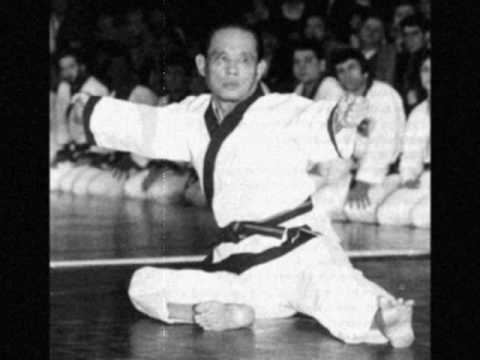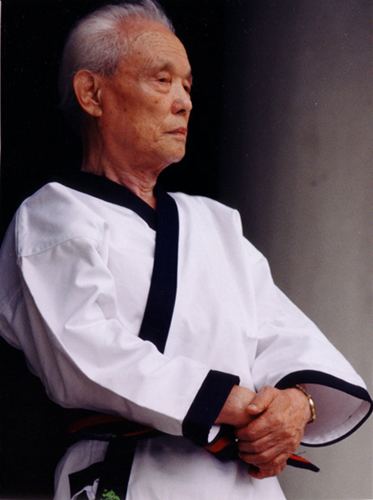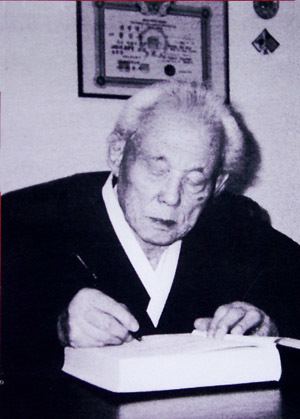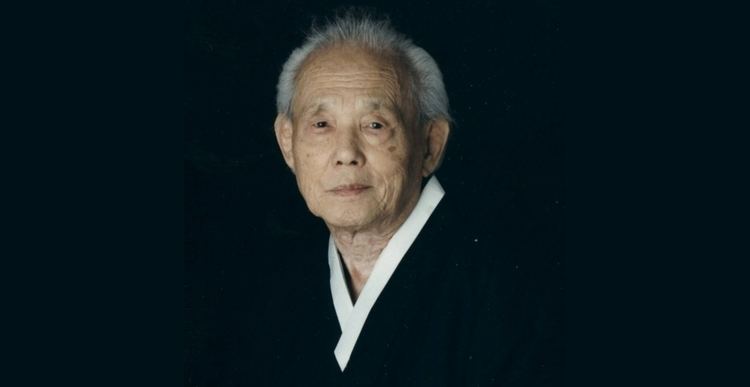Other names Hwang Gi Books Soo Bahk Do Trainer Yang Kook-Jin | Role Martial Artist Name Hwang Kee | |
 | ||
Born 황기, 黄琦November 9, 1914Gyeonggi, Korea ( 1914-11-09 ) Died July 14, 2002, Incheon, South Korea People also search for Chuck Norris, Howard Jackson, Song Duk-ki, Darnell Garcia | ||
Organizations founded Moo Duk Kwan | ||
Hwang Kee - Soo Bak Do - Moo Duk Kwan - Tang Soo Do
Hwang Kee (Hangul: 황기; Hanja: 黄琦; Hwang Gi; November 9, 1914 – July 14, 2002) was one of the most important and influential figures in the Korean martial arts. He was the founder of The Tang Soo Do, Moo Duk Kwan, and Soo Bahk Do and the school of Tang Soo Do Moo Duk Kwan.
Contents
- Hwang Kee Soo Bak Do Moo Duk Kwan Tang Soo Do
- Gm hwang kee
- Martial arts training
- Founding of his Moo Duk Kwan martial arts school
- Philosophy
- References

He was one of the five original Founders to open solely Korean Martial Arts Kwans, after the Japanese Occupation.

Gm hwang kee
Martial arts training

Hwang Kee was born on November 9, 1914, in Jang Dan, Kyong Ki province of Korea, while it was under Japanese occupation. His father was a scholar and teacher, thus Hwang was one of the few young men in the province to complete high school in 1935. He first studied martial arts, Tae Kyun while in school. Following graduation, he went to work for the Manchurian Railroad, where he claimed to have learned the martial art of Kuk Sool under Chinese Master Yang Kuk Jin, although some of his peers doubt this assertion. Master Won Kyuk Lee of the Chung Do Kwan, claimed that Hwang was a student at his kwan, gaining the equivalent of a green belt. Hwang disputed Lee's claim, and acknowledged only Yang Kuk Jin as his teacher. Hwang returned to Korea from China in 1937, he wanted to continue his martial education, but the Japanese occupation limited his options. Throughout the 1930s and 1940s, while working for the Cho Sun Rail Way Bureau, he began to study Okinawan Karate by reading books available at the local library.
Founding of his Moo Duk Kwan (martial arts school)
In 1945, grandmaster Hwang Kee formed his first school. Initially he titled his first school Hwa Soo Do ("Flowering Hand Way") Moo Duk Kwan, and his first two attempts at running a school were unsuccessful. In the early 1950s, he changed the name of his school to Tang Soo Moo Duk Kwan because Tang Soo (a direct Korean translation of Chinese and Japanese "Empty Hand") was more familiar to Koreans from their exposure to Japanese martial arts. Much of the philosophy and many of the original forms (poomse) and techniques were direct derivations of Shotokan Karate, first created by Gichin Funakoshi.
In 1957, Hwang claimed to have made several major discoveries in his reading the four hundred-page woodblock print Muye Dobo Tongji. The Muye Dobo Tongji was a book commissioned in 1790 by King Jeongjo of Korea, which illustrated indigenous Korean martial arts. Hwang Kee incorporated these teachings into his Tang Soo Do discipline and renamed the art he created Soo Bahk Do. By 1953 and onward until 1960, the Moo Duk Kwan had risen to become biggest Moo Do organization in Korea, with close to 75% of all martial artists in Korea practicing Tang Soo Do Moo Duk Kwan. In 1960, the Korean Soo Bahk Do Association was incorporated and registered with the Korean government as the traditional Korean martial art.

During the 50th anniversary celebration of the founding of the Moo Duk Kwan in 1995, Hwang Kee officially renamed the art from Tang Soo Do Moo Duk Kwan to Soo Bahk Do Moo Duk Kwan.
Philosophy
A distinctive philosophical component of Soo Bahk Do and some Tang Soo Do systems is the inclusions of guidelines and principles of Daoism (Taoism), created by Laozu and developed by Confucius.

One philosophy that Hwang included throughout his art was that no one could ever reach perfection. This was visible in his decision to use the Midnight Blue Belt over the Black Belt. This was also due to the fact the Koreans thought of black as the color of death (it also meant perfection though humans are never perfect), but the midnight blue sky was limitless, just like the training and knowledge that one could practice in a lifetime.
